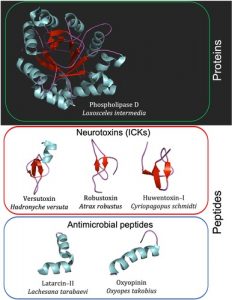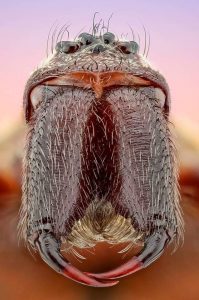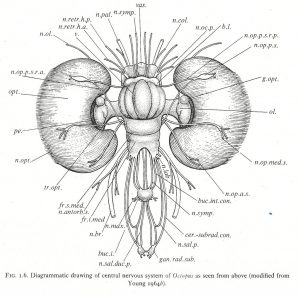If you’ve never heard of David Rives before, you’re fortunate: he’s a lesser creationist best known for the well-fed, smug, toothy smile of a prosperous real estate agent, and that he was formerly married to Jenna Ellis, former lawyer to Donald Trump who is now facing racketeering charges. It’s always sad when two hellbeasts get divorced.
Rives runs a creationist ministry with a YouTube channel in which he claims to be “changing the narrative.” He’s not. But I had to watch this video, title “Secrets of the Arachnids.” Before you jump in, though, I’ll warn you that the first 20 minutes is incredibly boring: he’s interviewing a dorky arachnologist named David Nelson, and aside from the vapid interjections of Rives, it’s mostly painless, and mostly the kind of stuff you might catch dorky me saying — he’s definitely enthusiastic about spiders. At about the 22 minute mark, though, I lose all sympathy for him.
We learn that David Nelson is a professor at Southern Adventist University in Chattanooga, Tennessee. Oh god. It’s one of those places.
The Biology and Allied Health Department fully supports a biblical six-day creation and developed the Origins Exhibit, a museum-quality display that showcases topics such as irreducible complexity of the cell, the geologic column, the flood, and dinosaurs.

Representatives of protein and peptide classes identified in spider venoms. Top panel: large proteins represented by Phospholipase D. Bottom two panels: short spider venom peptides divided into two major classes. The middle panel depicts selected neurotoxic ICK (inhibitor cystine knot) toxins (Versutoxin, Robustoxin and Huwentoxin-I). The lower panel shows representative antimicrobial peptides (Latarcin-II and Oxyopinin). Species names of spiders from which the components were isolated are indicated below the compound names. Secondary structures are indicated by colour (α-helices in blue, β-sheets in red, and turns in purple).
It’s a temple of misinformation. While I enjoyed the early part of his interview, when he’s talking about survey protocols and cool spider facts, it then goes off the rails when he starts talking about teaching a course in venoms and claiming that all venoms are flawed, degenerate versions of physiologically adaptive molecules, and that they support the biblical claim of a Fall and a loss of ‘information’. No, they’re not. If you read anything about The Biology and Evolution of Spider Venoms, you’d know that the components of a venom are complex and diverse. It’s not just a collection of failed phospholipase molecules, but a set of numerous, specialized molecules produced by duplication and divergence. It’s absurd to claim that this is a sign of biological decay.
Spider venom can contain up to 3000 different molecules, suggesting that the prospecting of all extant spider species could yield ~10 million venom components. Spiders therefore comprise a hyperdiverse lineage of predators with venom that is far more complex than that of most other animals.
Here’s a taste of the detail in the analysis of the structure of venoms. They are beautifully unique and specialized, and the Nelson gomer throws all the information away to claim it’s all about a loss of information. Yeah, guy, when you ignore all the information, it looks like a loss.
ICKs are the most abundant cysteine-stabilized peptides in nature: they are found in the venoms of many spiders and other animals, and have also evolved diverse functions in plants, fungi, bacteria and viruses (Undheim, Mobli & King, 2016). A fundamental obstacle hindering the evolutionary analysis of ICKs is the pseudoknot motif and its disulfide bonds, which are largely responsible for defining the tertiary structure of these peptides. Amino acid substitutions can therefore accumulate with little impact on structure, leading to profound diversity (Olivera et al., 1995; Sollod et al., 2005; Kozminsky-Atias & Zilberberg, 2012; Sunagar et al., 2013; Sunagar & Moran, 2015; Undheim et al., 2016). This challenge has been addressed recently by the application of ‘structural venomics’ (a combination of venom transcriptomics, proteomics and structural biology) in Hadronyche infensa to shed light on ICK evolution (Pineda et al., 2020). This approach showed that most ICK peptides are descendants of a single weaponized ICK lineage that underwent duplication and structural diversification, giving rise to a variety of peptides with elaborate ICK folds following their recruitment as venom components (Pineda et al., 2020). The ancestral ICK toxin was proposed either to contain a fourth disulfide bond that stabilized its β-sheet (lost in some descendants) or the typical three disulfide bonds with the fourth evolving independently at least twice (Pineda et al., 2020). Domain duplication would then explain the dICK peptides (Pineda et al., 2020). Structural venomics thus provides evidence that gene duplication is an important process in the evolution of spider venom and other venomous lineages. Similarly, gene duplication was proposed as an explanation for the evolution of αLTX in Latrodectus spp. (Gendreau et al., 2017; Schwager et al., 2017). However, it is important to note that the confident reconstruction of gene evolution processes requires genomic data. Results based exclusively on venomic data sets need to be interpreted with caution as assembly artifacts and overinterpretation can easily blur the evolutionary signature and lead to false assumptions. At least one ancient whole-genome duplication event is also thought to have occurred in the lineage leading to spiders and scorpions, providing the foundation for extensive neofunctionalization (Schwager et al., 2017).
You can’t talk about the evolution of anything without talking about neofunctionalization — that is, the emergence of new capabilities in evolving molecules. The science of venoms involves deducing where each toxin component came from, and dissecting the functional effect of each one.
Horizontal gene transfer has contributed to the evolution of some venom components, including PLD in the family Sicariidae (Cordes & Binford, 2018). PLD was traced to a single proteobacterial ancestor, from which it appears to have radiated widely, at least partially facilitated by horizontal gene transfer (Cordes & Binford, 2018). Horizontal gene transfer has also been proposed to explain the origin of αLTX, based largely on the complete genome sequence of Parasteatoda tepidariorum (Gendreau et al., 2017; Schwager et al., 2017).
What exactly does David Nelson teach in his venoms course? I am mystified. He seems to be building everything on flawed premises and an utter ignorance of the scientific literature. Does he hide PubMed from his students? Because two minutes with that would show that their professor is lying to them.
I haven’t even mentioned venom delivery systems. Does David Nelson teach that these represent a loss of function from a prelapsarian ideal?
Southern Adventist University ought to be shuttered and burned to the ground. Those poor students.













